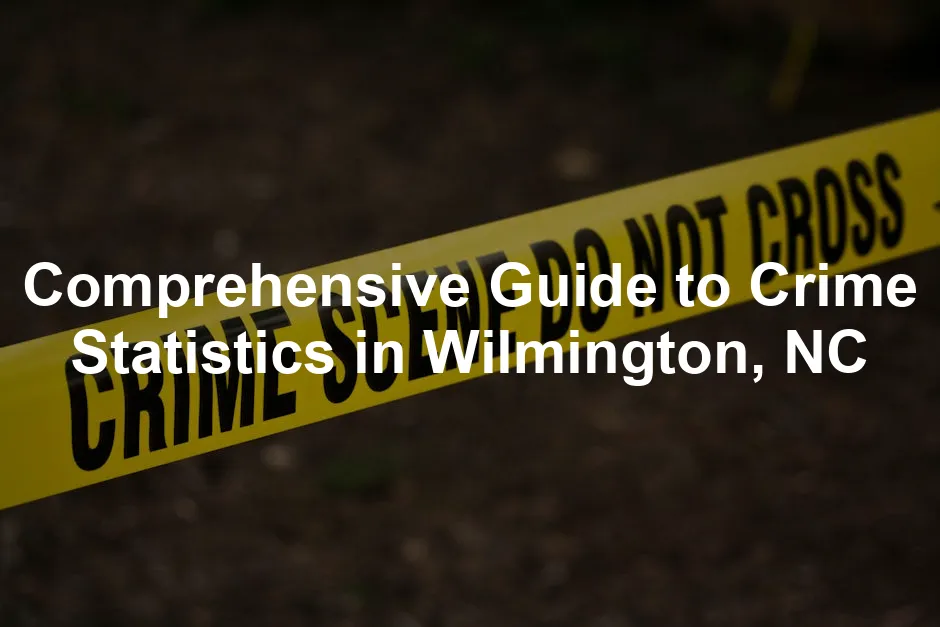Introduction
Understanding crime statistics in Wilmington, NC, is crucial for anyone considering a move here or for current residents. After all, knowledge is power! Awareness of local crime rates can help you make informed decisions about safety and community involvement.
Wilmington is a charming coastal city, known for its beautiful beaches, rich history, and vibrant culture. With a population of around 124,750, it’s a bustling hub of activity. But, like any city, it has its share of crime, and being aware of this reality is essential.
Data sources for this article include the FBI’s Uniform Crime Reporting (UCR) program, local police department statistics, and community surveys. These sources provide valuable insights into crime trends and patterns, helping the public stay informed about safety in their neighborhoods.
If you’re looking for a gripping read to understand the complex world of crime and punishment, check out Crime and Punishment by Fyodor Dostoevsky. This classic novel delves deep into the psyche of its characters and the moral dilemmas they face, making it a thought-provoking addition to your bookshelf.

Understanding Crime Statistics
What Are Crime Statistics?
Crime statistics are numerical data that reflect the occurrence of various crimes within a specific area. They are essential for assessing public safety and understanding crime trends. With this information, residents can make informed decisions about their communities.
Crime statistics can be broken down into two main categories: violent crimes and property crimes.
Types of Crimes
Violent crimes include serious offenses such as murder, assault, robbery, and rape. These crimes pose a direct threat to individuals and public safety. On the other hand, property crimes encompass offenses like burglary, theft, and motor vehicle theft. While these may not directly harm individuals, they can significantly impact the community’s sense of security.
Wilmington’s crime landscape is shaped by these categories. Analyzing both types of crimes helps residents understand the specific challenges their community faces.
To gain a deeper understanding of crime and justice, consider adding The New Jim Crow by Michelle Alexander to your reading list. This book explores the systemic issues in the criminal justice system and is a must-read for anyone interested in social justice and reform.

Crime Rate Calculation
How Crime Rates Are Calculated
Understanding how crime rates are calculated is essential for interpreting the statistics correctly. Crime rates typically express the number of crimes per a set population, often per 1,000 or 100,000 residents. This method allows for a fair comparison between areas of different sizes.
To calculate the crime rate, law enforcement agencies collect data on reported crimes. Then, they adjust these figures based on the population size. For example, if Wilmington has 759 violent crimes and a population of 124,750, the violent crime rate would be calculated as follows: (759 / 124,750) * 100,000, resulting in a rate per 100,000 residents.
This per capita approach provides a clearer picture of crime prevalence, enabling residents and policymakers to assess safety effectively. It ensures that a small town doesn’t appear safer just because it has fewer total crimes, while its larger counterparts might face greater challenges.

Comparative Analysis
Comparing Wilmington’s crime rates to those of other cities, both statewide and nationally, is crucial for context. Wilmington’s overall crime rate stands at 34 per 1,000 residents, significantly higher than the national average. In fact, over 83% of communities in North Carolina boast lower crime rates than Wilmington.
Understanding these comparisons helps residents gauge their safety relative to other areas. For instance, while Wilmington faces challenges, examining cities like Cary or Asheville can shed light on what effective crime prevention strategies look like. These comparisons are vital for potential movers contemplating Wilmington as a new home; they provide a more comprehensive understanding of what living in Wilmington might entail.
If you’re intrigued by the psychological aspects of crime, consider picking up Mindhunter by John E. Douglas. It provides a fascinating insight into the minds of serial killers and the FBI’s methods in profiling them.

Types of Violent Crimes
Murder Rates
In Wilmington, the murder rate is a crucial statistic. With recent data indicating a total of 12 murders, Wilmington’s rate stands at approximately 10.1 per 100,000 residents. While this figure may seem alarming, it’s important to note that this rate is less than some larger cities. However, every life lost is a tragedy, and the community is continually working to lower this number. Local initiatives and outreach programs aim to address root causes, from economic disparities to community engagement.
Additionally, crime literature can be an eye-opener, which is why you should consider reading The Devil in the White City by Erik Larson. This book intertwines a fascinating historical narrative with true crime, exploring the dark side of the 1893 World’s Fair.

Assault, Rape, and Robbery
Assaults make up the bulk of violent crimes in Wilmington, totaling 434 incidents, giving it a rate of 364.2 per 100,000 residents. Rape cases are at 77, which translates to a rate of 64.6 per 100,000. Robbery incidents are also notable, with 111 reported, leading to a rate of 93.2. These statistics paint a picture of the challenges Wilmington faces. Local law enforcement is actively addressing these issues through community policing and crime prevention programs, focusing on building trust and safety in neighborhoods.
For those interested in the intricacies of criminal behavior, you might find The Complete Idiot’s Guide to Criminal Psychology a delightful read. It breaks down complex psychological concepts into understandable terms, making it perfect for curious minds!

Property Crimes Breakdown
Statistics
Property crimes are another major concern in Wilmington, with a significant total of 3,415 incidents reported. This results in a property crime rate of 28 per 1,000 residents. The chance of becoming a victim of property crime stands at 1 in 35, making awareness and precaution essential for residents.

Theft, Burglary, and Vehicle Theft
Breaking down the property crimes further, theft accounts for the majority, with 2,675 incidents, while burglaries reach 470, and motor vehicle thefts total 270. The theft rate of 2,244.9 per 100,000 is particularly striking, indicating a need for enhanced security measures among residents. Local authorities are implementing strategies to combat these crimes, such as neighborhood watch programs and community awareness campaigns.
For those looking to dive deeper into crime scene investigations, Crime Scene Investigation: Methods and Procedures by David A. Stout is a comprehensive guide that can enlighten you on the techniques used in forensic science.

Neighborhood Crime Analysis
Neighborhoods with Highest and Lowest Crime Rates
High Crime Areas
Certain neighborhoods in Wilmington experience higher crime rates, with areas like downtown and some parts of the north side facing challenges. Economic factors play a significant role here. High population density can lead to increased opportunities for crime, coupled with economic struggles that foster criminal behavior. Community leaders are actively working on initiatives to improve conditions in these areas, focusing on job creation and youth engagement to deter crime.
For those who enjoy crime dramas, The Wire: The Complete Series is a must-watch. It provides a raw and realistic portrayal of crime in Baltimore, offering insights that resonate with many urban areas, including Wilmington.

Low Crime Areas
Conversely, neighborhoods such as Cypress Island and Woodlake boast lower crime rates. These areas often feature more affluent populations, better access to resources, and active community involvement in local safety initiatives. The sense of community in these neighborhoods contributes significantly to their safety, proving that when residents work together, they can create a secure environment.
Understanding these dynamics helps residents make informed decisions about where to live or invest in Wilmington. As the city continues to grow, balancing safety with growth will be crucial in shaping the future of Wilmington.

Community Sentiment
Local Perception of Safety
Wilmington’s residents have mixed feelings about safety. According to a recent survey, about 66% of respondents express concerns about crime, especially during nighttime. However, 34% feel a sense of security, believing that crime is minimal in their neighborhoods. This sentiment reflects a community grappling with safety concerns. People often discuss their worries on social media platforms, sharing stories about local incidents and safety tips. Clearly, the perception of safety varies widely among Wilmingtonians, highlighting the importance of community engagement in addressing these concerns.

Law Enforcement Feedback
Residents’ views on local law enforcement are equally varied. In surveys, 58% of respondents believe that police are visible and responsive. However, 29% feel that officers are slow to respond when needed. Only a small fraction thinks police presence is lacking. These perceptions reveal a community that’s somewhat divided on law enforcement effectiveness. Many residents appreciate the efforts made to increase police visibility, particularly in high-crime areas. Nevertheless, concerns about response times persist, suggesting room for improvement in community-police relations.

Factors Influencing Crime in Wilmington, NC
Economic and Social Factors
Poverty and Employment
Economic conditions play a significant role in Wilmington’s crime rates. The city’s poverty rate stands at 19.2%, higher than the national average of 15.1%. This economic struggle often correlates with rising crime rates. When people lack stable jobs, the temptation to engage in criminal activities increases. Areas with high unemployment tend to experience more property crimes and violent offenses. Efforts to promote job growth and economic stability could potentially reduce crime, making Wilmington a safer place to live.
Want to understand more about the economic impacts on crime? Pick up The Crime Book: Big Ideas Simply Explained. It uses engaging visuals to break down the complexities of crime and its societal impacts.

Education Levels
Education levels also impact crime rates in Wilmington. The city boasts a high school graduation rate of 87.6%, which is above the national average. However, educational attainment varies by neighborhood. Studies show that communities with lower education levels often experience higher crime rates. Investing in education, vocational training, and community programs can create a more informed populace, ultimately leading to a reduction in crime. Education is a powerful tool; the more educated individuals feel empowered to seek better opportunities, the less likely they are to resort to crime.
For those who enjoy self-improvement literature, How to Win Friends and Influence People by Dale Carnegie is a fantastic read. It teaches valuable interpersonal skills that can lead to better community engagement and support.

The Opioid Crisis and Crime
Impact of Substance Abuse
Wilmington is not immune to the opioid crisis affecting many areas across the United States. The opioid epidemic has led to increased crime rates, particularly in drug-related offenses. Local law enforcement reports indicate a correlation between substance abuse and rising property crimes, including theft and burglary. As addiction rates climb, so do the challenges for Wilmington’s community. The police department actively engages in initiatives to combat this crisis, including distributing Narcan to reverse overdoses. Addressing substance abuse is crucial for enhancing public safety and reducing crime in Wilmington.
If you’re interested in understanding the psychological aspects of crime, consider reading The Psychology of Criminal Conduct by Darrin R. Lehman. It delves into the motivations behind criminal behavior, offering insights that can help communities address root causes.

Urbanization and Population Density
Growth and Crime
Wilmington, NC, is on the rise! With a population density of 2,376.5 people per square mile, it’s bustling with energy (and a few crime challenges). As more folks flock to this coastal charm, the implications for crime are significant. Urbanization often brings about increased crime rates due to higher population density. This creates more opportunities for criminal activity.
But hold on! It’s not all doom and gloom. A growing population can also bring resources and community engagement that help combat crime. Neighborhood watch programs and community events thrive in active areas. When residents band together, they can create a safer environment. Wilmington’s growth could lead to innovative crime prevention strategies.
For those who enjoy thriller movies, Gone Girl by Gillian Flynn is a gripping tale that explores the darker sides of relationships and crime. It’s a riveting watch that keeps you guessing!
Recent Developments
Crime Trends Over the Last Decade
Wilmington has seen a rollercoaster of crime statistics over the past ten years. According to recent data, the overall crime rate has fluctuated, yet some key insights emerge. From 2013 to 2023, Wilmington experienced a slight uptick in violent crime, but property crime rates have seen a decline. In 2022, the city recorded 634 violent crimes, reflecting a 3% increase from the previous year, while property crimes have decreased by approximately 4%. This shows that while challenges remain, there’s hope for improvement.
Initiatives like CompStat have made a difference. Implemented in 2017, this program helps police track crime data effectively. It allows for timely decisions about resource allocation. The results? Increased visibility of police in high-crime areas and a focus on crime prevention. Wilmington’s law enforcement is adapting to the crime dynamics, aiming to create a safer community.
For a deeper dive into crime documentaries, The Killing (DVD) is a compelling watch that delves into the investigation of a murder case, showcasing the complexities of law enforcement.

Community Programs
Community programs play a vital role in combating crime in Wilmington. One standout initiative is Crime Stoppers. This program encourages residents to report suspicious activity anonymously. It rewards individuals for tips that lead to arrests, boosting community involvement in crime prevention. The conviction rate for cases solved through Crime Stoppers tips is an impressive 95%.
Local organizations also host events to foster community spirit. Programs focusing on youth engagement aim to provide alternatives to crime. By offering recreational activities and mentorship, Wilmington’s community programs are demonstrating that proactive efforts can lead to a decrease in crime.
FAQs
Is Wilmington, NC safe?
Wilmington has crime rates higher than the national average. However, many neighborhoods are considered safe, especially when community involvement is strong.
What are the most dangerous areas in Wilmington?
Areas such as downtown Wilmington and certain northern neighborhoods have higher crime rates. But remember, safety can vary by block!
How does Wilmington’s crime rate compare to other cities?
Wilmington’s crime rate is higher than over 83% of communities in North Carolina, making it essential to stay vigilant.
What can residents do to improve safety in their neighborhoods?
Residents can participate in neighborhood watch programs, report suspicious activities, and engage with local law enforcement to foster a safer community.
Please let us know what you think about our content by leaving a comment down below!
Thank you for reading till here 🙂
All images from Pexels




